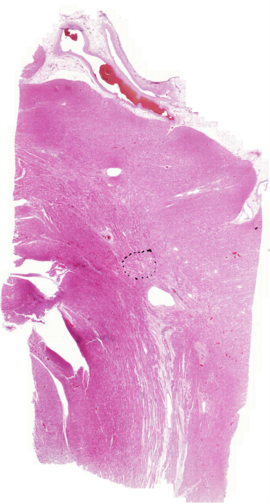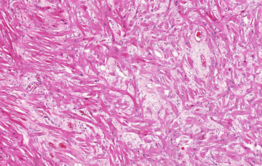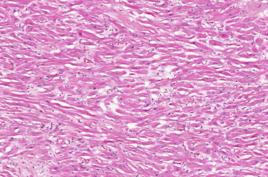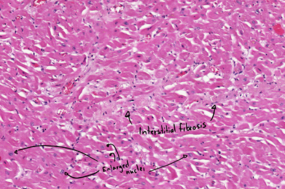40. Hypertrophic cardiomyopathy: Difference between revisions
No edit summary |
No edit summary |
||
| (One intermediate revision by the same user not shown) | |||
| Line 1: | Line 1: | ||
[[File:Hypertrophic cardiomyopathy overview.png|thumb|The marked area is where you’ll find the evidence for hypertrophic cardiomyopathy. | | [[File:Hypertrophic cardiomyopathy overview.png|thumb|The marked area is where you’ll find the evidence for hypertrophic cardiomyopathy. |504x504px]]'''Staining''': HE | ||
'''Organ''': Myocardium | '''Organ''': Myocardium | ||
| Line 9: | Line 9: | ||
'''Causes''': Genetic defects | '''Causes''': Genetic defects | ||
'''Theory''': | '''Theory''': Hypertrophic cardiomyopathy has the same microscopic morphology as simple hypertrophic myocardium, but also has areas where there is ''loss of orientation''. ''If you have trouble recognizing the slide you can remember the blocky appearance of the upper right corner of the slide.''[[File:Hypertrophic cardiomyopathy close-up.png|thumb|Close-up of that area. Note how the myocardial fibres have no direction. Compare with the picture below|left|262x262px]] | ||
[[File:Hypertrophic cardiomyopathy longitudinal.png|thumb|From the same slide, but from an area without loss of orientation|left|268x268px]] | |||
Hypertrophic cardiomyopathy has the same microscopic morphology as simple hypertrophic myocardium, but also has areas where there is ''loss of orientation''. ''If you have trouble recognizing the slide you can remember the blocky appearance of the upper right corner of the slide.'' | [[File:Hypertrophic cardiomyopathy perpendicular.png|thumb|Normal signs of hypertrophic myocardium|285x285px]] | ||
[[File:Hypertrophic cardiomyopathy close-up.png|thumb|Close-up of that area. Note how the myocardial fibres have no direction. Compare with the picture below|left]] | |||
[[File:Hypertrophic cardiomyopathy longitudinal.png|thumb|From the same slide, but from an area without loss of orientation|left]] | |||
[[File:Hypertrophic cardiomyopathy perpendicular.png|thumb|Normal signs of hypertrophic myocardium]] | |||
[[Category:Pathology 1 - Histopathology slides]] | [[Category:Pathology 1 - Histopathology slides]] | ||
Latest revision as of 13:08, 5 July 2024

Staining: HE
Organ: Myocardium
Description: We can see the normal signs of hypertrophic myocardium: interstitial fibrosis, enlarged nuclei and (some) lipofuscin pigment. In an area almost in the exact middle of the slide is an area where the myocardial cells have lost their orientation.
Diagnosis: Hypertrophic cardiomyopathy
Causes: Genetic defects
Theory: Hypertrophic cardiomyopathy has the same microscopic morphology as simple hypertrophic myocardium, but also has areas where there is loss of orientation. If you have trouble recognizing the slide you can remember the blocky appearance of the upper right corner of the slide.



